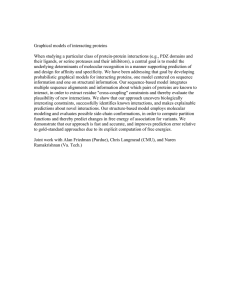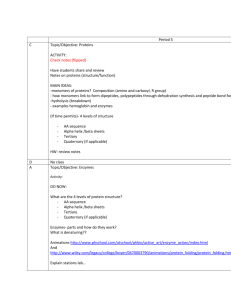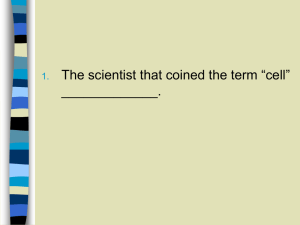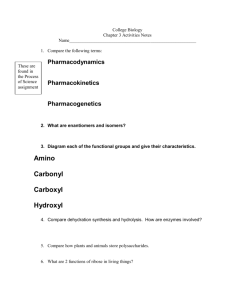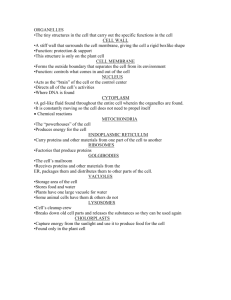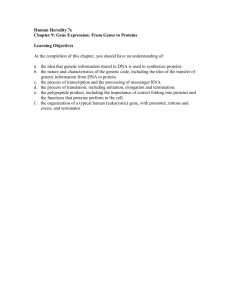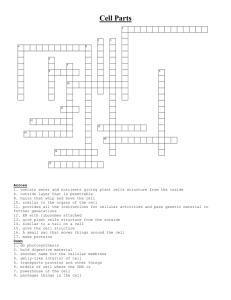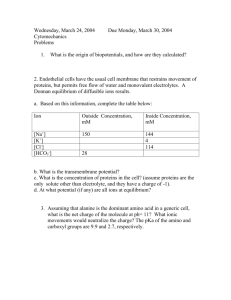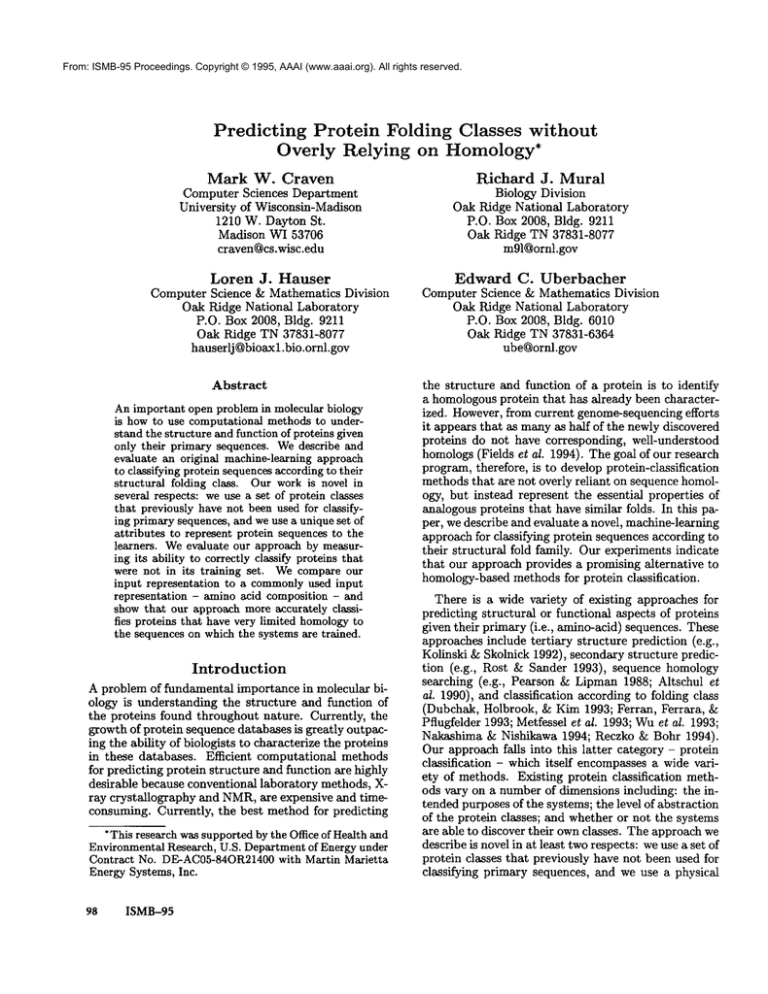
From: ISMB-95 Proceedings. Copyright © 1995, AAAI (www.aaai.org). All rights reserved.
Predicting
Protein Folding Classes without
Overly Relying on Homology*
Mark W. Craven
Richard J. Mural
Computer Sciences Department
University of Wisconsin-Madison
1210 W. Dayton St.
Madison WI 53706
craven@cs.wisc.edu
Biology Division
Oak Ridge National Laboratory
P.O. Box 2008, Bldg. 9211
Oak Ridge TN 37831-8077
m91~ornl.gov
Loren J. Hauser
Computer Science & Mathematics Division
Oak Ridge National Laboratory
P.O. Box 2008, Bldg. 9211
Oak Ridge TN 37831-8077
hauserlj@bioaxl.bio.ornl.gov
Abstract
An important open problem in molecular biology
is howto use computational methods to understand the structure and function of proteins given
only their primary sequences. Wedescribe and
evaluate an original machine-learning approach
to classifying protein sequencesaccordingto their
structural folding class. Our work is novel in
several respects: we use a set of protein classes
that previously have not been used for classifying primary sequences, and we use a unique set of
attributes to represent protein sequences to the
learners. Weevaluate our approach by measuring its ability to correctly classify proteins that
were not in its training set. Wecompare our
input representation to a commonlyused input
representation - amino acid composition - and
show that our approach more accurately classifies proteins that have very limited homologyto
the sequences on which the systems are trained.
Introduction
A problem of fundamental importance in molecular biology is understanding the structure and function of
the proteins found throughout nature. Currently, the
growth of protein sequence databases is greatly outpacing the ability of biologists to characterize the proteins
in these databases. Efficient computational methods
for predicting protein structure and function are highly
desirable because conventional laboratory methods, Xray crystallography and NMR,axe expensive and timeconsuming. Currently, the best method for predicting
*This research was supported by the Office of Health and
Environmental Research, U.S. Department of Energy under
Contract No. DE-AC05-84OR21400
with Martin Marietta
EnergySystems, Inc.
98
ISMB-95
Edward C. Uberbacher
Computer Science & Mathematics Division
Oak Ridge National Laboratory
P.O. Box 2008, Bldg. 6010
Oak Ridge TN 37831-6364
ube@ornl.gov
the structure and function of a protein is to identify
a homologousprotein that has already been characterized. However, from current genome-sequencingefforts
it appears that as manyas half of the newly discovered
proteins do not have corresponding, well-understood
homologs(Fields et al. 1994). The goal of our research
program, therefore, is to develop protein-classification
methods that are not overly reliant on sequence homology, but instead represent the essential properties of
analogous proteins that have similar folds. In this paper, we describe and evaluate a novel, machine-learning
approach for classifying protein sequences according to
their structural fold family. Our experiments indicate
that our approach provides a promising alternative to
homology-basedmethods for protein classification.
There is a wide variety of existing approaches for
predicting structural or functional aspects of proteins
given their primary (i.e., amino-acid) sequences. These
approaches include tertiary structure prediction (e.g.,
Kolinski &Skolnick 1992), secondary structure prediction (e.g., Rost & Sander 1993), sequence homology
searching (e.g., Pearson & Lipman 1988; Altschul et
a/. 1990), and classification according to folding class
(Dubchak, Holbrook, & Kim 1993; Ferran, Ferrara,
Pflugfelder 1993; Metfessel et al. 1993; Wuet al. 1993;
Nakashima & Nishlkawa 1994; Reczko & Bohr 1994).
Our approach falls into this latter category - protein
classification - which itself encompassesa wide variety of methods. Existing protein classification methods vary on a number of dimensions including: the intended purposes of the systems; the level of abstraction
of the protein classes; and whether or not the systems
are able to discover their ownclasses. The approach we
describe is novel in at least two respects: we use a set of
protein classes that previously have not been used for
classifying primary sequences, and we use a physical
set of attributes to represent protein sequences.
Our approach uses machine-learning methods to induce descriptions of sixteen protein-folding classes.
The folding classes that we use were devised by Orengo
et al. (1993) in a large-scale computational effort
cluster proteins according to their structural similarity.
These classes comprise analogous, as well as homologous proteins. Whereas Orengo et al. used structural
information to classify proteins, we are interested in
classifying proteins when only their primary sequences
are available. Thus, the role of the machine-learning
algorithms in our approach is to induce mappings from
primary sequences to folding classes. A key aspect
of our method is the way in which we represent primary sequences to the learner. Unlike most proteinclassification approaches, which represent proteins by
their amino-acid composition, our method represents
proteins using attributes that better capture the commonalities of analogous proteins. Weempirically compare learning systems that use our input representation
to learning systems that use amino-acid composition as
their input representation. Weshow that our approach
more accurately classifies proteins that have very limited homology to the sequences on which the systems
are trained.
Problem Representation
The task that we address is defined as follows: given
the amino-acid sequence of a protein, assign the protein to one of a numberof folding classes. This problem
definition indicates that there are two fundamental issues in implementing a classification
method for the
task: determining the attributes that are to be used to
represent protein sequences, and defining the classes
that are to be predicted. The remainder of this section
discusses how we address these two issues.
Class Representation
The classes that we use in our approach are the fold
groups defined by Orengoet al. (1993) in their effort
identify protein-fold families. These classes represent
proteins that have highly conserved structures, but often low sequence similarity. Thus, the classes represent
analogous, as well as homologous, proteins. Table 1
lists the fold groups that we use as our classes, as well
as the numberof examples in each class that we use in
our experiments, and whether each class falls into the
a (primarily alpha), /7 ( primarily beta), a//~ (alternating a and/~), or a +/7 (non-alternating a and/7)
family (Levitt & Chothia 1976).
The method that Orengo et al. used to define their
fold groups involved four primary steps.
1. A set of proteins with known folds was assembled
from the Brookhaven Protein Data Bank (Bernstein
et 02. 1977).
2. The proteins in this set were clustered according to
sequence similarity.
Using the Needleman-Wunsch
Table 1: Protein class representation.
The middie columnlists the classes we use in our classification
method. The left column indicates class families, and
the right column lists, for each class, the number of
examples we use in our experiments.
aln
a+~
total
group)-~
Globin
Orthogonal
EF Hand
Up/Down
Metal Rich
Orthogonal Barrel
Greek Key
Jelly Roll
Complex Sandwich
Trefoil
Disulphide Rich
TIM Barrel
Doubly Wound
Mainly Alpha
Sandwich
Beta Open Sheet
examples
~ examples
27
14
5
7
16
5
24
5
7
7
11
15
26
9
20
14
212
algorithm (Needleman & Wunsch 1970), they performed pairwise comparisons on 1410 protein sequences selected in the previous step. They then
used single-linkage cluster analysis to form clusters
of related sequences. In single-linkage cluster analysis, two proteins, a and b, are assigned to the same
cluster if there exists a chain of proteins linking a
and b, such that each adjacent pair in the chain satisfies a defined measure of relatedness. Twoproteins
were deemedrelated, in this case, if their sequence
identity was > 35%. For small proteins, this threshold was adjusted using the equation of Sander and
Schneider (Sander & Schneider 1991). Also, for proteins with 25-35%sequence identity, a significance
test was used to determine if the proteins were to be
considered related.
3. A representative protein was selected from each of
the clusters formed in the previous step, and the
resulting set of proteins was clustered according to
structural similarity. Pairwise comparisons of proteins in this set were done using a variant of the
Needleman-Wunsch algorithm that compared structural environments rather than primary sequences.
4. Multidimensional scaling was applied to the resulting structural homology matrix to form clusters of
proteins with similar folds. The final fold groups
were defined from this clustering by human interpretation, with the aid of schematic representations
and topology diagrams.
In summary, Orengo et al. organized proteins
with knownstructures into classes representing simiCraven
. ....................................................................................................................................................................................................
.............................................
99
lar folds, but not necessarily similar primary sequences.
Whereas, Orengoet al. developed their classes by clustering proteins according to structural similarity, we
are interested in classifying protein sequences whose
structures have not been determined. Obviously, their
method is not applicable in such cases since it takes
structural information as input. Our approach therefore uses mac3aine-learning methods to induce mappings from primary sequences to folding classes.
Our data set is formed in the following manner: For
each of the fold groups listed in Table 1, we select
between one and five of the examples that are representatives (as listed by Orengoet al.) of the clusters
formed in step 2. above. Note that this set contains
sequences with only very limited homology. Wethen
use each of these proteins as a query sequence to search
the SWmS-PROT
database (Bairoch & Boeckman 1992)
for similar sequences. Weuse both BLAST(Altschul et
a/. 1990) and FASTA(Pearson & Lipman 1988) for
quence comparisons. As many as nine examples are
extracted from each search and added to our data set
to increase the number of examples for each fold.
Input
Representation
In order to employ a machine-learning method in this
task, it is necessary to define an input representation;
that is, a schemefor representing the proteins that are
given to the system. The input representation that we
use for our protein classification approach involves a
small number of attributes that can be readily computed from the primary sequence of a given protein.
The attributes that we use are the following:
¯ Average residue volume: Using values that represent the volume of each amino acid’s side group
(Dickerson & Geis 1969), we calculate the average
residue volume for a given sequence.
¯ Charge composition: We use three attributes
to
represent the fraction of residues in a given sequence
that have positive charge, negative charge, and neutral charge (Lehninger, Nelson, & Cox 1993).
¯ Polarity composition: We use three attributes to
represent the fraction of residues in a given sequence
that are polar, apolar, and neutral (Lehninger, Nelson, & Cox 1993).
¯ Predicted a-helix//3-sheet
composition: One of
these attributes represents the fraction of the protein’s residues that are predicted to occur in ahelices, the other represents the fraction that are
predicted to occur in /3-sheets. Note that both of
these values are merely predictions, since the problem of calculating secondary structure from primary
structure is exceptionally difficult itself. Our predictions are generated by a neural network that we
trained using the data set of Qian and Sejnowski
(1988). The trained network is scanned along the
protein sequence, generating a prediction of a,/3 or
lOO ISMB-95
coil for each residue. The numberof a and/3 predictions are summedand then divided by the sequence
length.
¯ Isoelectric
point: Using the Wisconsin Sequence
Analysis Package (version 6.0) (Devereux, Haeberli,
&Smithies 1984), we calculate the isoelectric point
of the given sequence.
¯ Fourier transform of hydrophobicity function:
Using hydrophobicity values for each amino acid, we
convert a given sequence into a one-dimensional hydrophobicity function, H. Wecalculate the modulus
of the Fourier transform of this function as follows
(Eisenberg, Weiss, &Terwilliger 1984):
I.n=l
.I
n=l
where/~(~) is the value for the periodicity with frequency ~, and n ranges over the residues in the
sequence. Wecalculate this function at 1° intervals from 0° (corresponding to a period of infinity)
to 180° (corresponding to a period of 2 residues).
Finally, the six hydrophobicity attributes we use
are computed by averaging values over each nonoverlapping 30° interval in [0 °, 180°].
Wenormalize the values for the volume, isoelectric, and
hydrophobicity attributes so that they fall in the range
[0, 1]. Values for the other attributes naturally lie in
this range.
Empirical
Evaluation
The underlying hypotheses of our approach are:
¯ The folding class of a protein can be accurately predicted, given only its primary sequence.
¯ The best representation for this classification task is
one that attempts to capture the commonalities of
analogous proteins that are in the same folding class.
Manyprotein-classification studies have represented
proteins by their amino-acid composition (Klein
Delisi 1986; Nakashima, Nishilmwa, & Ooi 1986;
Dubchak, Holbrook, & Kim 1993; Metfessel et al.
1993), or by some description of the amino-acid n-mers
that occur in sequences (Ferran, Ferrara, &Pflugfelder
1993; Nakashima & Nishikawa 1994; Reczko & Bohr
1994). Our hypothesis is that this type of representation is not well suited to the classification of proteins
that have no close relatives in existing databases, or
that have no close relatives whose structure has been
determined. Weconjecture that methods trained using
such a representation will perform poorly when asked
to classify proteins that do not have homologs in the
training set. Our view is that protein-classification
methods should be aimed at characterizing proteins
that do not have well-understood homologs.
In order to test our hypotheses, we present a number
of experiments that evaluate our approach. First, we
measure how well several machine-learning algorithms
generalize 1 to unseen examples after learning to classift proteins using our problem representation. As a
baseline for comparison, we also measure generalization for the same learning algorithms when amino-acid
composition is used as the input representation. Our
second experiment evaluates the relative contributions
of the various attributes that comprise our input representation. Our third experiment tests the ability of
systems trained using our representation to generalize
to test cases for which there are no close relatives in
the training set. This is a key experiment because our
approach is motivated by the need to characterize proteins for which there are not any well-understood homologs. Finally, we demonstrate that the accuracy of
our approach can be improved by having trained classitiers classify only examplesfor which they are confident
in their predictions.
Measuring
Generalization
The first task that we address in our experiments is to
measure the accuracy of learners trained using our input and output representations. As a baseline for comparison, we also evaluate learners trained using aminoacid composition as their input representation. This
representation has twenty attributes,
each of which
represents the fraction of a protein sequence that is
composed of a particular amino acid.
Weuse several different learning algorithms to evaluate these two representations, since we do not know
a priori which algorithm has the most appropriate
inductive bias for each representation.
Weevaluate
three inductive learning algorithms: C4.5 (Quinlan
1993), feed-forward neural networks (Rumelhart, Hinton, & Williams 1986), and k-nearest-neighbor classitiers (Cover & Hart 1967). Weevaluate the suitability
of these algorithms for the protein-classification task
by estimating their generalization ability. In order to
estimate generalization for each learning method, we
2conduct leave-one-out cross-validation runs.
C4.5 is an algorithm for learning decision trees. The
complexity of the trees induced by C4.5 can be controlled by pruning trees after learning. In our experiments, we run C4.5 both without pruning, and with
pruning confidence levels ranging from 10%to 90%.
The neural networks that we use in our experiments
are fully connected between layers, and have 3, 5, 10,
20 or no hidden units. Weuse the logistic activation
function for hidden units, and the "softmax" activation
function (Bridle 1989) for output units. The softmax
1 Generalization refers to howaccurately a systemclassifies examplesthat are not in its training set.
2In leave-one-outcross-validation, classifiers are trained
on n - 1 of the n available examplesand then tested on the
exampleleft out. This process is repeated n times, so that
each exampleis used as the testing exampleexactly once.
Table 2: Test-set accuracy using leave-one-out
cross validation. For each algorithm listed in the left
column, the middle columnlists the resulting test-set
accuracy when our input representation is used. The
right column lists test-set accuracy when mnino-acid
composition is used as the input representation.
learning
method
C4.5
nearest-neighbor
neural networks
test-set
our
representation
60.8%
80.7
83.0
accuracy
amino-acid
representation
49.1%
76.9
70.8
function defines the activation of unit i as:
ai -- Y~n e~’~
where ~i is the net input to unit i, and n ranges over
all of the output units. The networks are trained
using the cross-entropy error function (Hinton 1989),
and a conjugate-gradient
learning method (Kramer
Sangiovanni-Vincentelli 1989), which obviates the need
for learning-rate
and momentumparameters. Networksare trained until either (1) they correctly classify
all of the training-set examples, (2) they converge
a minimum, or (3) 1000 search directions have been
tried. The networks have one output unit per class;
the class associated with the most active unit is taken
as the network’s prediction for a given test exampie. Since the solution learned by a neural network
is dependent upon its initial weight values, for all of
our neural-network experiments we perform four crossvalidation runs, using different initial weight settings
each time.
For k-nearest-neighbor classifiers, we use a Euclidean
distance metric to measure proximity. Weconstruct
classifiers that use values of k ranging from 1 to 10.
The class predicted by a nearest-neighbor classifier is
the plurality class of the k training examples that are
nearest to a given test example. Ties are broken in
favor of the nearest neighbor.
Table 2 reports leave-one-out accuracy for the best
parameter settings for each learning method. The middle columnlists the measured accuracy values for classifters trained using our input representation. The
right columnlist accuracy values for classifiers trained
using amino-acid composition as their input representation. For both input representations, we found that
pruning did not improve C4.5’s generalization on this
task, thus we report the accuracy of unpruned trees.
For neural networks, the best results were obtained using 20 hidden units for our input representation, and
no hidden units for the amino-acid representation. For
the nearest-neighbor method, the best results were obtained by using k=3 for our input representation, and
k=l for the amino-acid representation.
Craven
101
The accuracy values we list for the neural networks
are averages over four cross-validation runs. The standard deviations for these averages are less than 0.1%,
and thus we do not list them in the table. Weomit
standard deviations from the other tables in the paper
for the same reason.
Wedraw two conclusions from this experiment. The
first is that it is possible to classify protein primary
sequences into Orengoet al.’s folding groups with high
accuracy; the neural networks using our input representation were 83.0% accurate on test cases. The second conclusion we make is that our input representation is a better representation than amino-acid composition for this task. For all three learning methods,
our representation resulted in superior generalization.
Evaluating
The Input
Representation
In our second experiment, we seek to understand how
muchthe individual attributes that comprise our input
representation contribute to the overall performance of
the classifiers.
To measure this, we conduct a series
of leave-one-out cross-validation runs using nearestneighbor classifiers (with k=3, the best value of k in the
previous experiment), and input representations that
contain only subsets of the attributes defined in the
Input Representation section of this paper. First, we
conduct leave-one-out runs in which the input representations consists only of individual attribute groups.
For example, in one run we classify instances using
only the charge composition attributes as our input
representation. Wealso conduct leave-one-out runs in
which we use all of the attributes except for a selected
group. For example, in one run we classify examples
using an input representation that consists of all of the
attributes except for the charge composition attributes.
Table 3 reports the results of this experiment. The
left columnin the table lists the attribute groups. The
middle column reports test-set accuracy for runs in
which we use only a singie attribute group. The right
column reports test-set accuracy for cross-validation
runs in which we use all of the attributes except for the
indicated group. Note that the last row in the table
lists the cross-validation accuracy that we measured
for nearest-neighbor classifiers using our original input
representation.
As the values in the middle column indicate, none
of the attribute groups alone are as predictive as the
entire attribute set. The values in the right column
indicate that every attribute group contributes to the
predictiveness of the original input representation. Although most of the accuracy values in this column are
close to the accuracy of the entire attribute set, none
of them equals or exceeds it. From these results we
conclude that all of the attributes in our input representation make some contribution to the predictiveness
of our classifiers.
102
ISMB-95
Table 3: Evaluating attribute predictiveness.
The table lists accuracy results for leave-one-out crossvalidation runs with nearest-neighbor classifiers using
selected attribute subsets. The middle column reports
accuracy for input representations that use only the
indicated attributes. The right column reports accuracy for input representations that omit the indicated
attributes.
leaving
IonlyUSing out
attributes
average residue volume
18.9%
78:3%
charge composition
21.7
78.8
polarity composition
31.6
79.2
a-helix/fLsheet composition
29.7
77.8
isoelectric point
15.1
76.9
FT of hydrophobicity
48.6
59.9
all attributes
80.7 ¯ q
Estimating
the
Role
of Homology
Although the results presented in the first experiment
indicate that we are able to classify proteins with high
accuracy, they do not really address our primary concern; namely, that we want to accurately classify proteins whenthe classifier’s training set does not contain
sequences that are homologousto the test sequences.
In this section, we present an experiment in which each
test set has very limited homologyto its corresponding
training set.
As in previous experiments, we use cross-validation
to estimate the accuracy of our classifiers. Unlike the
previous experiments, however, the training and test
sets in this experiment vary in size. The training and
test sets for this experiment are formed by first partitioning the set of examplesfor each class into separate subsets, such that homologousproteins fall into
a single subset. Recall that we formed our data set
in the following manner: First, non-homologous sequences were selected from Orengo et al.’s data set.
Sequences with 35%or greater sequence identity were
considered homologous. For sequences with 25-35%
sequence identity, a significance test was used to decide if the sequences were considered homologous. We
then expanded our data set by using each of these sequences as a query sequence to find close relatives in
the SWISS-PROTdatabase. The resulting groups of
homologous sequences correspond to the partitions we
use in this experiment.
This partitioning of the examples allows us to do
cross-validation runs in which we ensure that for every
memberof the test set there is not a close relative in
the classifier’s training set. A cross-validation run, in
this experiment, involves using each of the subsets as
the test set exactly once. The examplesfor four of the
classes, a:EF Hand, a: Up/dovm, ~: Complex Sandwich,
and ~: Trefoil, are not used in this experimentsince all
Table 4: Test-set accuracy factoring out the role
of homology. The training sets in this experiment do
not contain sequences that are homologousto the test
sequences.
learning
method
C4.5
nearest-neighbor
neural networks
test-set
our
representation
32.5%
36.6
40.1
accuracy
amino-acid
representation
25.5%
30.6
23.1
membersof these classes share high sequence identity.
As in the first experiment, we run each algorithm
several times using a range of parameter settings. C4.5
is run with pruning confidence levels ranging from 10%
to 90%, and without pruning. We train neural networks with 3, 5, 10, 20 and no hidden units. Nearestneighbor classifiers use values of k from 1 to 10.
Table 4 shows the results of this experiment for the
best parameter settings for each learning method. As
in our first experiment, we found that the best decisiontree generalization was achieved without pruning, As
before, we also found that the best neural-network
generalization was with networks that had 20 lfidden
units for our input representation, and no hidden units
for the amino-acid representation.
For the nearestneighbor method, the best results were obtained by
using k=4 for our input representation,
and k=3 for
the amino-acid representation.
The classification accuracy values reported for this
experiment are all significmltly worse than their counterparts in the first experiment. For the best classifier
- a neural network trained using our input representation - generalization dropped from 83.0% to 40.1%.
There are several reasons for this decrease in accuracy.
One factor is that, due to our partitioning of the data,
the training sets used in the second experiment are
smaller than those used in the first. Someof the training sets had only one or two examples for some classes.
The more important factor, however, is that homology
plays a large role in the predictive ability of the classitiers described in our first experiment.
Although the results of this experiment are somewhat disappointing, they also lend support to our hypothesis that our input representation is better than
one based on amino-acid composition. For all three
learning algorithms, the classifiers trained using our input representation generalized significantly better than
the classifiers using the amino-acid input representation. This result confirms that our representation embodies more of the commonalities of analogous proteins
than does the amino-acid representation.
Table 5 showsper-class sensitivity values for our neural networks’ predictions. The sensitivity of a set of
predictions for class c is defined as the percentage of
Table 5: Neural-network
sensitivity
measurements by class. The middle column shows per-class
sensitivity values for the first experiment (leave-oneout cross validation). The right column shows sensitivity values for the third experiment (no test-set example has a homolog in the training set). Sensitivity
is defined as the percentage of examplesin a class that
are correctly predicted.
class
Globin
Orthogonal
EF Hand
Up/Down
Metal Rich
Orthog. Barrel
Greek Key
Jelly Roll
Complex Sand.
Trefoil
Disulphide Pdch
TIM Barrel
Doubly Wound
Mainly Alpha
Sandwich
Beta Open Sheet
leave-one-out
sensitivity
96.3%
71.4
80.0
85.7
93.8
60.0
79.2
80.0
71.4
85.7
72.7
80.0
92.3
88.9
65.0
92.9
no-homologs
sensitivity
96.3%
7.1
75.0
0.0
39.6
10.0
0.0
43.3
53.8
16.7
15.0
3.6
membersof class c that are correctly identified as belonging to c. The table displays sensitivity values for
both the first experiment (leave-one-out) and this one
(no homologs). This table indicates that the accuracy
of our predictions is not uniform across the classes,
especially in the no-homologs experiment. As previously mentioned, poor performance for some classes is
at least partly explained by sparse training sets. The
poor predictability of some classes mayalso be due to
the classes themselves being artificial constructs. It is
important to keep in mind that the class structure itself was devised through a combination of automated
clustering and human interpretation.
Many of these
classes encompass diverse groups of proteins, and in
some cases, the class boundaries are rather arbitrary.
Improving
Examples
Accuracy
by Rejecting
Although the classification accuracy values reported in
the previous experiment are rather low, we have found
that the accuracy of our classifiers can be improvedby
taking into account the confidence of their predictions.
In this section, we describe an experiment in which we
employ a strategy that is commonlyused in the domain of handwritten character recognition: classifiers
’~reject" (i.e., do not classify) examplesfor which they
cannot confidently predict a class (Le Cun et al. 1989).
In our fourth experiment, we evaluate neural net-
Craven
103
works and nearest neighbor classifiers using the same
training and test sets as in the previous experiment
(i.e., no test-set example has a homologin the training set). Weuse single-nearest-neighbor classifiers and
neural networks with 20 hidden units. For every testset example, a confidence value is output along with
the predicted class.
There are various algorithm-specific heuristics that
can be used to estimate a classifier’s confidence in a
given prediction. For nearest-neighbor algorithms, we
measure a prediction’s confidence as how large we can
make k while ensuring that the k nearest neighbors
are unanimous in the class they predict. For neural
networks, we measure confidence as the fraction:
ai
where a~ is the activation of the unit corresponding to
the predicted class, and n ranges over all of the output
units (actually the normalization is superfluous when
the softmax activation function is used).
By establishing a threshold on the confidence values,
we are able to have classifiers reject examplesfor which
they are uncertain. Figure 1 displays generalization as
a function of the percentage of examples rejected, for
both neural networks and nearest-neighbor classifiers.
The left edge of the graph represents the case where
no examples are rejected. The right edge of the graph
represents the case where 80%of the examples are rejected. For both methods, the curves climb steadily,
meaning that the classifiers improve their accuracy as
they throw out more examples.
The results of this experiment are interesting because they suggest that even if we cannot develop a
classifier that is highly accurate for a wide range of
proteins, we can perhaps develop a classifier that is
highly accurate for certain classes of proteins, and is
able to determine whentest cases fall into these classes.
Future
Work and Conclusions
There are several open issues that we plan to explore
in future research. These include: investigating alternative input representations, developing an alternative class structure, predicting folding classes for multidomain proteins, and using distributed output representations. Wediscuss each of these in turn.
Although experiments presented in Section indicate
that our input representation is superior to the commonly used amino-acid representation, we believe that
our representation can be improved by incorporating
additional attributes. For example, we plan to investigate attributes based on the Fourier transform of signals formed by residue volumes and charges.
Defining a set of protein-folding classes is a difficult
problem in itself. To date we have used the folding
groups identified by Orengoet al. as our classes. Some
of these classes are rather arbitrarily defined, however,
and hence difficult to predict. Weplan to re-evaluate
104
ISMB-95
lOO%
O
I neuralnetWorks
nearest-deighbor
clasiifiers
-,,,-,
8o%
8
400/o
fi
o%
20%
i
40%
60%
exarnp4es
rejected
80%
Figure 1: Rejection curves. The x-axis indicates the
fraction of examples rejected. The y-axis indicates the
corresponding accuracy.
our current class structure to determine if some of the
classes should be redefined, aggregated or discarded.
Another important and difficult
issue to be addressed in our future research is how to predict the
folding class of multi-domain proteins which do not
fall completely into one of our existing classes. An
accurate prediction for such a protein might involve
labeling different domainsof the protein with different
classes. Since our approach enables subsequences of
proteins to be represented and classified, the key problem to be solved in this task is how to parse protein
sequences into subsequences. One possible approach is
to generate secondary-structure predictions for a given
protein, and then to use the predicted a-helix/fLsheet
boundaries to suggest alternative parses.
Finally, we plan to investigate the utility of using
a distributed output representation during learning.
In a distributed representation, each of the problem
classes is represented using a bit-string in which more
than one bit is "on". A carefully engineered encoding
schemecan result in significantly better generalization
(Dietterich & Bakiri 1995).
Wehave presented a novel machine-learning approach to classifying proteins into folding groups. Our
method uses attributes that can be easily computed
from the primary sequence of a given protein. Wehave
presented experiments that show that our approach is
able to classify proteins with relatively high accuracy.
Wehave also demonstrated that our input representation is superior to a representation based on amino-acid
composition, especially when classifying proteins which
have no homologs in the training set. The goal of our
research program is to develop computational methods
that are able to accurately classify proteins that have
no well-understood homologs. Webelieve that the research presented herein represents a promising start
towards this goal.
Acknowledgments.
The authors
would like to
thank Carolyn Allex and the anonymousreviewers for
their insightful commentson this paper.
References
Altschul, S. F.; Gish, W.; Miller, W.; Myers, E. W.;
and Lipman, D. J. 1990. Basic local alignment search
tool. Journal of Molecular Biology 215(3):403-410.
Bairoch, A., and Boeckman, B. 1992. The Swiss-Prot
protein sequence data bank. Nucleic Acids Research
20:2019-2022.
Bernstein, F.; Koeyzle, T.; Williams, G.; Meyer, J.;
Brice, M.; Rodgers, J.; Kermard, O.; Shimanouchi,
T.; and Tatsumi, M. 1977. The protein data bank:
A computer-based archival file for macromolecular
structures. Journal of Molecular Biology 112:535-542.
Bridle, J. 1989. Probabilistic interpretation of feedforward classification network outputs, with relationships to pattern recognition. In Fogelman-Soulie,
F., and H~rault, J., eds., Neurocomputing: Algorithms, Architectures, and Applications. NewYork,
NY: Springer-Verlag.
Cover, T. M., and Hart, P. E. 1967. Nearest neighbor
pattern classification.
IEEE Transactions on Information Theory 13(1):21-27.
Devereux, J.; Haeberli, P.; and Smithies, O. 1984. A
comprehensive set of sequence analysis programs for
the VAX.Nucleic Acids Research 12:387-395.
Dickerson, R. E., and Geis, I. 1969. The structure and
action of proteins. Menlo Park, CA: W. A. Benjamin.
Dietterich,
T. G., and Bakiri, G. 1995. Solving
multiclass learning problems via error-correcting output codes. Journal of Artificial Intelligence Research
2:263-286.
Dubchak, I.; Holbrook, S. R.; and Kim, S.-H. 1993.
Prediction of protein folding class from amino acid
composition. Proteins: Structure, Function, and Genetics 16:79-91.
Eisenberg, D.; Weiss, R. M.; and Terwilliger, T. C.
1984. The hydrophobic momentdetects periodicity in
protein hydrophobicity. Proceedings of the National
Academy of Sciences, USA 81:140-144.
Ferran, E. A.; Ferrara, P.; and Pflugfelder, B. 1993.
Protein classification using neural networks. In Proceedings of the First International Conference on
Intelligent Systems for Molecular Biology, 127-135.
Bethesda, MD: AAAIPress.
Fields, C.; Adams, M. D.; White, O.; and Venter,
J. C. 1994. How many genes in the human genome?
Nature Genetics 7(3):345-346.
Hinton, G. 1989. Connectionist learning procedures.
Artificial Intelligence 40:185-234.
Klein, P., and Delisi, C. 1986. Prediction of protein structural class from the amino acid sequence.
Biopolymers 25:1659-1672.
Kolin~ki, A., and Skolnick, J. 1992. Discretized model.
of proteins. I. Monte Carlo study of cooperativity
in homopolypeptides. Journal of Chemical Physics
97(12):9412-9426.
Kramer, A. H., and Sangiovanni-Vincentelli, A. 1989.
Efficient parallel learning algorithms for neural networks. In Touretzky, D., ed., Advances in Neural Information Processing Systems, volume 1. San Marco,
CA: Morgan Kaufmann. 40-48.
Le Curt, Y.; Boser, B.; Denker, J. S.; Henderson,
D.; Howard, R. E.; Hubbard, W.; and Jackel, L. D.
1989. Handwritten digit recognition with a backpropagation network. In Touretzky, D., ed., Advances
in Neural Information Processing Systems, volume 2.
San Mateo, CA: Morgan Kauhnann.
Lehninger, A. L.; Nelson, D. L.; and Cox, M. M. 1993.
Principles of Biochemistry. New York, NY: Worth
Publishers.
Levitt, M., and Chothia, C. 1976. Structural patterns
in globular proteins. Nature (London) 261:552-557.
Metfessel, B. A.; Saurugger, P. N.; Cormelly, D. P.;
and Rich, S. S. 1993. Cross-validation of protein
structural class prediction using statistical clustering
and neural networks. Protein Science 2:1171-1182.
Nakashima, H., and Nishikawa, K. 1994. Discrimination of intracellular and extracellular proteins using
amino acid composition and residue-pair frequencies.
Journal of Molecular Biology 238:54-61.
Nakashima, H.; Nishikawa, K.; and Ooi, T. 1986.
The folding type of a protein is relevant to its amino
acid composition. Journal of Biochemistry (Tokyo)
99:153-162.
Needleman, S. B., and Wunsch, C. D. 1970. A general methodapplicable to the search for similarities
in the amino acid sequence of two proteins. Journal
of Molecular Biology 48:443-453.
Orengo, C. A.; Flores, T. P.; Taylor, W. R.; and
Thornton, J. M. 1993. Identification
and classification of protein fold families. Protein Engineering
6(5):485-500.
Pearson, W. R., and Lipman, D. J. 1988. Improved
tools for biological sequence comparison. Proceedings
of the National Academy of Sciences, USA 85:24442448.
Qian, N., and Sejnowski, T. 1988. Predicting the
secondary structure of globular proteins using neural network models. Journal of Molecular Biology
202:865-884.
Quinlan, J. R. 1993. C~.5: Programs for Machine
Learning. San Mateo, CA: Morgan Kaufmann.
Reczko, M., and Bohr, H. 1994. The DEFdata base of
sequence based protein fold class predictions. Nucleic
Acids Research 22(17):3616-3619.
Craven
105
Rost, B., and Sander, C. 1993. Prediction of protein secondary structure at better than 70%accuracy.
Journal of Molecular Biology 232:584-599.
Rumelhart, D.; Hinton, G.; and Williams, R. 1986.
Learning internal representations by error propagation. In Rumelhart, D., and McClelland, J., eds.,
Parallel Distributed Processing: Explorations in the
microstrneture of cognition. Volume 1: Foundations.
Cambridge, MA: MIT Press. 318-363.
Sander, C., and Schneider, R. 1991. Database of
homology-derived protein structures and the structural meaning of sequence alignment. Proteins:
Structure, Function and Genetics 9:56-68.
Wu, C.; Berry, M.; Fung, Y.-S.; and McLarty, J.
1993. Neural networks for molecular sequence classification. In Proceedings of the First International
Conference on Intelligent Systems for Molecular Biology, 429-437. Bethesda, MD:AAAIPress.
106
ISMB-95

